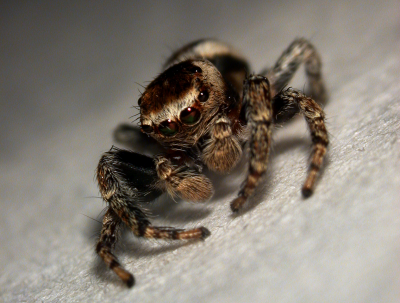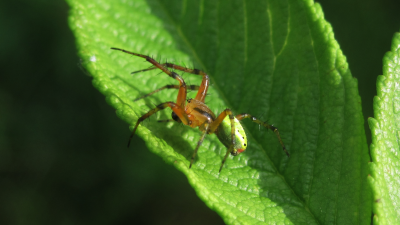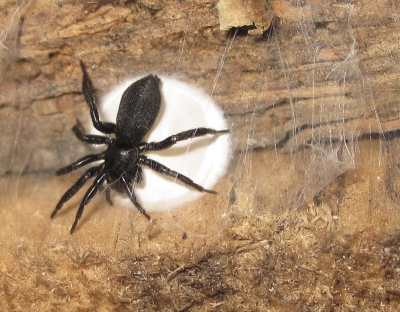 2006
2006
 2008
2008
 2010
2010
 2012
2012
 2014
2014



 |
‘Spider cannot live by a fly alone’
‘Taxonomic characterization of prey of web building spiders and actively hunting spiders’
MICHAŁ BUCZYŃSKI – author of photographs Why are your eyes so big? – asked… a fly (stereomicroscope) like a chameleon Love in black and white colours (Little black) |

|
Description popularizing the research project
It is not so easy to be a predator. Getting food requires a lot of efforts and energy. Potential prey is not easy to catch – most often, they run away as quickly as they only can, sometimes they fight ferociously for their life. It happens that the chase is fruitless, the prey runs away and the exhausted hunter ends up without a meal. It is even harder to be a predatory invertebrate. Their killer skills and successful hunt depend on lucky coincidence, thanks to which a predator and its prey meet, and ambient temperature, which limits mobility of both of them. That is why spiders, nearly all of them being perfect hunters, often fast for long weeks. In favourable conditions, spiders have a very diverse diet. Spiders are not very choosy about their food and they just eat anything trapped in their intricate webs or not too big and fast to be caught with their chelicerae. It is not always a fly, equally or even more often, it is a butterfly, a moth, a cricket, a bug, a springtail, a beetle or an ant. The latter one, although, is rarely eaten, as most of spiders do not like formic acid. Sometimes other animals, not necessarily insects, meet the condition of ‘catchability’ e.g. snails, centipedes, earthworms or woodlice, becoming a balanced meal on a spider’s menu. There is no reason why a big enough spider could not hunt a small enough vertebrate. That is the reason why arachnologists find small fishes, amphibians, lizards, snakes, birds, bats and minute rodents among the prey of spiders. It is a typical diet of relatively big tropical spiders. They do not have any respect for other spiders too, even of their own species. Attacks on their own relatives are not rare among the smart eight-legged predators. Diversity of their prey, much richer than just a fly, allows calling them one of the most efficient predators of all times. Sometimes catching prey without spending any energy. Are they the evolutionary archetype of TV dinners or food delivery?
Abstract
Spiders are small inverterbrates and omnipresent predators. They present a variety of adapta-tions, hunting tactics, which make them one of the most dangerous and supreme, despite their small size, predators of the animal world. That versatility translates into an enormous range of the prey included in the diet of spiders. Most of the spiders are not limited to one type of prey (although there are some). It is true that insects are they main food but our associative fly some-times is rare and represents only a small part of their menu. Small, medium sized, and larger insects, weak ones and these stronger ones, fast ones as well as those slow ones, the ones with protection in form of an armor and the unarmored ones. Insects that fly, run, jump, or crawl. Diptera, hymenoptera, hemiptera, coleoptera, collembola, lepidoptera, orthoptera – none of them are safe and each can fall prey to a spider. And this is only a small part of the spider "diet". Of course, insects are not the only food of spiders. Their diet includes more nutritious snails or slow earthworms; tiny, armored isopods or centipedes rolled in a tight "ball". Spiders deal perfectly with the challenges posed by more demanding potential preys. They have vari-ous ways to do so. They can wait patiently perfectly still; build intricate, specialized cobwebs; actively and gradually disarm their prey or attack it almost imperceptibly for the human eye. Spiders can be also dangerous to each other. Arachnophagy and cannibalism among them are widespread phenomena. Although it is usually a result of frequent, but accidental meetings of these predators. For members of some families spiders are particularly preferred food and target of hunting. Talking about victims of spiders, we would not say the whole truth about them if we said they are limited only to invertebrates. Amazing is the fact that such small predators can be dangerous for, sometimes much larger than them, vertebrates. Fishes, lizards, snakes and birds, bats or small rodents, although rarely, may also fall their prey. The aim of this work was analysis of the richness and diversity of prey of these “small hunters” and of course gathering information about the subject available in literature.
Patronat honorowy
Leszek Jodliński
Dyrektor Muzeum Śląskiego w Katowicach
Zygmunt Łukaszczyk
Wojewoda Śląski
Jan Malicki
Biblioteka Śląska
Piotr Uszok
Prezydent Katowic
Adam Matusiewicz
Marszałek Województwa Śląskiego
















